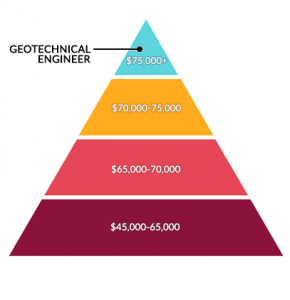Geotheta Fundamentals Explained
Geotheta Fundamentals Explained
Blog Article
The Main Principles Of Geotheta
Table of ContentsThe Greatest Guide To GeothetaThe Main Principles Of Geotheta Geotheta Can Be Fun For AnyoneIndicators on Geotheta You Need To KnowThe Facts About Geotheta Uncovered

They conduct site investigations, accumulate examples, perform lab examinations, and assess data to assess the suitability of the ground for building and construction tasks - Consulting Engineers. Based on their findings, geotechnical designers give recommendations for foundation design, slope security, retaining structures, and mitigation of geotechnical risks. They collaborate with other professionals, such as architects, structural engineers, and construction groups, to make certain that geotechnical factors to consider are incorporated right into the overall job layout and execution
By assessing the behavior and residential or commercial properties of soil and rock, they can recognize possible geotechnical risks such as landslides, soil settlement, or incline instability. Their knowledge assists avoid failures or crashes that could threaten lives and home. Right here are some detailed tasks and responsibilities of a geotechnical designer: Website Examination: Geotechnical engineers conduct site investigations to gather information on subsurface conditions.
They translate the information to understand the homes and behavior of the dirt and rock, including their strength, leaks in the structure, compaction qualities, and groundwater conditions. Geotechnical Analysis and Layout: Geotechnical engineers analyze the information gathered throughout site examinations to evaluate the security and suitability of the website for building jobs. They perform geotechnical calculations and modeling to review elements such as bearing capability, negotiation, slope stability, lateral earth stress, and groundwater flow.
Some Known Factual Statements About Geotheta
Structure Style: Geotechnical engineers play a critical role in making foundations that can securely support the desired structure. They analyze the soil problems and tons requirements to identify the appropriate structure kind, such as superficial foundations (e.g., footings), deep structures (e.g (https://www.intensedebate.com/people/geotheta)., piles), or specialized techniques like dirt improvement. They consider elements such as negotiation restrictions, bearing capability, and soil-structure communication to develop ideal structure layouts
They evaluate building strategies, display website tasks, and conduct area assessments to confirm that the style referrals are complied with. If unforeseen geotechnical issues emerge, they assess the situation and supply suggestions for remediation or changes to the design. Threat Analysis and Mitigation: Geotechnical engineers assess geotechnical dangers and threats connected with the job site, such as landslides, liquefaction, or soil disintegration.

Collaboration and Interaction: Geotechnical designers work carefully with various other experts entailed in a job, such as engineers, architectural engineers, and building teams. Efficient communication and collaboration are essential to integrate geotechnical factors to consider into the total task design and building process. Geotechnical engineers offer technical proficiency, answer questions, and make certain that geotechnical needs are fulfilled.
Not known Details About Geotheta
Right here are some kinds of geotechnical designers: Structure Designer: Structure engineers specialize in developing and evaluating foundations for structures. They assess the soil conditions, tons needs, and website attributes to determine the most appropriate structure type and style, such as superficial foundations, deep structures, or specialized strategies like heap foundations.
They evaluate the elements affecting incline security, such as soil residential or commercial properties, groundwater conditions, and slope geometry, and create approaches to protect against slope failures and minimize dangers. Quake Engineer: Quake engineers focus on evaluating and designing frameworks to stand up to seismic pressures. They evaluate the seismic danger of a website, assess dirt liquefaction capacity, and create seismic style standards to guarantee the safety and security and durability of frameworks during earthquakes.
They carry out field testing, collect examples, and evaluate the gathered information to identify the dirt homes, geologic developments, and groundwater conditions at a site. Geotechnical Instrumentation Designer: Geotechnical instrumentation designers concentrate on surveillance and determining the actions of soil, rock, and frameworks. They mount and preserve instrumentation systems that keep track of aspects such as dirt negotiation, groundwater levels, incline movements, and structural variations to assess performance and provide very early warnings of potential problems.
The 2-Minute Rule for Geotheta
They perform examinations such as triaxial examinations, consolidation tests, straight shear tests, and leaks in the structure examinations to collect information for geotechnical evaluation and style. Geosynthetics Engineer: Geosynthetics engineers concentrate on the design and application of geosynthetic materials, such as geotextiles, geogrids, and geomembranes. They use these materials to improve soil security, enhance slopes, supply water drainage options, and control erosion.
They often tend to be investigative individuals, which indicates they're intellectual, reflective, and curious. They are curious, methodical, sensible, analytical, and logical. A few of them are likewise social, implying they're kind, generous, cooperative, client, caring, practical, empathetic, sensible, and pleasant. Does this audio like you? Take our complimentary job examination to learn if geotechnical designer is among your leading profession matches.
In the workplace environment, geotechnical engineers make use of specialized software application tools to perform computations, develop designs, and examine information. They prepare records, evaluation job specs, interact with customers and employee, and coordinate task tasks. The office setup gives a favorable environment for research study, analysis, and collaboration with various other experts associated with the job.
Geotheta Can Be Fun For Everyone
They frequently visit project sites to perform website examinations, assess geotechnical conditions, and collect information for evaluation. These brows through involve taking a trip to various locations, sometimes in remote or difficult surfaces. Geotechnical engineers might do dirt tasting, conduct examinations, and monitor construction tasks to make certain that the geotechnical facets of the task are being implemented correctly.
Geotechnical designers also have a peek at this site work in specialized geotechnical labs. Geotechnical laboratory designers work thoroughly in these settings, taking care of testing equipment, running tools, and recording data.
Report this page